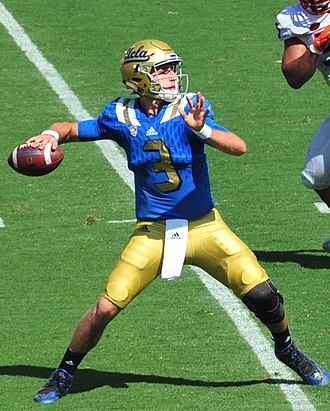You have /5 articles left.
Sign up for a free account or log in.

Josh Rosen of the University of California, Los Angeles
Wikipedia
Last Thursday night I briefly tuned in to the spectacle that is the National Football League draft. I like pro football, but I don’t want to think about it year-round, and I don’t get the fascination with the vertical jump and the 40-yard dash as measures of talent, athleticism and even character. I’m far from convinced that hand size matters in either quarterbacks or presidents.
There are certainly parallels between the National Football League draft process and the college admissions process. Both are about identifying talent, both weigh past performance against future potential and both use a variety of data points as short cuts to make judgments and projections.
The big story on Thursday was that a record five quarterbacks were selected in the first round, including four of the first 10 picks. The prevailing wisdom in the NFL is that a team can’t win without a “franchise” quarterback, even though the Philadelphia Eagles won the Super Bowl with a backup quarterback after the starter was injured. This year’s draft includes an intriguing group of potential franchise quarterbacks.
The real story is how little agreement there is among pro teams about the relative merits and flaws of this year’s group. Is Baker Mayfield, the Heisman Trophy winner from Oklahoma, too short? Is Josh Allen from Wyoming too raw? Is Sam Darnold from Southern California too careless with the ball? Is Josh Rosen from UCLA too much of a free thinker? And is Lamar Jackson from Louisville seen as too black, a victim of outdated but pervasive stereotypes about what a quarterback should look like?
The larger historical story line is how lousy professional football teams are at identifying which standout college quarterbacks will turn into successful pros. With all the scouting, all the testing and all the time spent evaluating film, identifying a decent -- much less star -- quarterback seems like a crapshoot.
Are there lessons for those of us in the college admissions arena? Do we rely on data points that don’t measure what is most important in being successful in college and life? Are we beholden to assumptions that deserve more scrutiny and skepticism?
Teams in the NFL and other professional sports are constantly looking for scouting, training and coaching secrets that will provide them with a competitive advantage. Is the same true of college admissions? Do colleges and universities possess admissions-related trade secrets?
That issue came up several weeks ago during a hearing in U.S. District Court in Boston, part of the lawsuit filed by Students for Fair Admissions against Harvard University for its treatment of Asian-American applicants. Students for Fair Admissions had asked that 90,000 pages of Harvard admission documents be made public, arguing that release of the documents would lead Judge Allison D. Burroughs to issue a summary judgment without need for a trial. The documents had previously been made available to the court as part of the discovery process.
Lawyers for Harvard argued against public release of the documents on two grounds. One was that public release of admission records for individual applicants would constitute an invasion of their privacy. The other is that documents about Harvard’s admissions process contain “proprietary information.”
Harvard is not the first university to make the claim that there are trade secrets in admissions. Princeton University made a similar claim last year in the lawsuit it faced from Students for Fair Admissions. But are admissions practices proprietary, and will public release of how Harvard recruits and admits its freshman class be damaging or merely embarrassing?
It is interesting for Harvard to make the claim that it needs to keep its admission policies and practices secret, because there is no other college or university in America that wouldn’t love to have Harvard’s name recognition, reputation and market position. This spring Harvard admitted fewer than 5 percent of its applicants, and last year 84 percent of those admitted enrolled, a yield rate substantially higher than at any other college or university in the country. But is Harvard’s success tied to its admission policies and procedures or its unparalleled longevity and wealth?
I haven’t worked in the admissions office at Harvard, so perhaps I am missing something, but it is hard to imagine that it uses recruiting strategies fundamentally different and more effective than other ultraselective universities. I also have a hard time believing that Harvard reads applications differently than its competitors. Even if it did and the proprietary information was released, would any other institution be able to cut into the Harvard brand?
So what are Harvard and other institutions worried about becoming public? My guess is the process known as “shaping” the class.
At the conference I attended a couple of weeks ago, I encountered a term I had never heard before -- “shaping cohort.” I believe that is what we used to call the admissions committee, except that it functions at the end of the admissions process to ensure that the admitted class has the right balance to achieve a number of institutional objectives, objectives ranging from net revenue to profile to diversity of various kinds. Shaping is great for the institution and less so for those individual applicants who may not help achieve the desired shape.
Shaping is not new in college admission. Jerome Karabel has argued that college admission has always been guided by what he calls the Iron Law of Admission. In essence the Iron Law states that admission offices have always been motivated first by achieving a certain result, with admission processes developed because they achieve the goal. At worst that can become a kind of reverse engineering, and part of the argument being made on behalf of Asian-American applicants is that, just like Jewish students in the 1920s, they would earn a greater percentage of admission places at colleges like Harvard and Princeton except that they don’t fit the predetermined shape of the class.
Two nights before the start of the NFL draft, fans of the Philadelphia 76ers of the National Basketball Association chanted, “Trust the process,” as their team won its first-round playoff series. The “process” for the 76ers involved losing lots of games over multiple seasons while accumulating draft choices to build a winning team, and it received lots of ridicule before starting to pay off this year. But do they trust the process or just the result?
And what about those of us in the college admission profession? Do we trust our processes, or are they merely a means to achieving a certain end result? Are we trustworthy, modeling transparency and the pursuit of truth? Does shaping really produce a better mix of students or a better educational experience? Should college admission be proprietary or open source?








